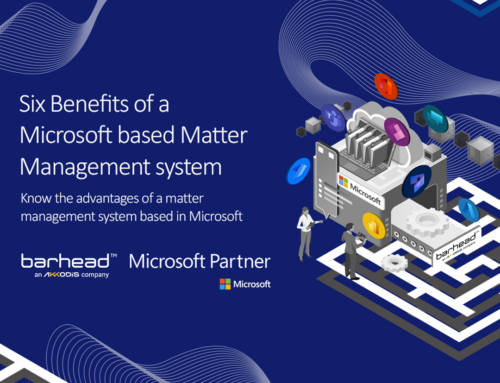Choosing a contract lifecycle management (CLM) system can be tricky. However, adopting a Microsoft-based CLM arguably makes more financial sense. Dozens of CLMs on the market will share similar features and benefits, but a Microsoft-based CLM takes digital contracting and puts these benefits on steroids.
Here are 10 features and benefits that a Microsoft-based CLM does better:
1. Azure data security
CLMs are all about data. You need to know where the data is stored, which systems you need to pull and push data in-between as well as any security weaknesses along the way. A Microsoft CLM not only gives you confidence in the security of your data but also allows you to maintain control of the data in your Azure environment with a central source of information.
2. Microsoft data interoperability
A Microsoft-based CLM reduces siloes by bringing together disparate data sets across your business. It seamlessly integrates with other business processes across the entire procurement journey such as Marketing, Sales, Finance and Operations and HR, without the need for custom APIs or complicated bespoke integrations.

3. Business application scalability
At the core of Microsoft’s Power Platform are universal and scalable workflows and processes that enable IT teams to scale the system as the organisation grows. Processes – which are not bespoke to legal or procurement – can be replicated and utilised by other functions in businesses engaged in similar workflows.
4. Familiarity and high user adoption
Customer journey orchestration is all about treating the customer as an individual, with highly personalised communications and actions, rather than grouping them into segments of similar customers. With the amount of data you are collecting about your customers, you can now personalise communication at scale, and you can trigger actions based on real time events, such as checking in to an event, or landing on a particular page on your website, reaching customers at the moments they are interacting with you, via their preferred communication channel. New capabilities coming in this space in 2022 will include the ability to use Power Automate to trigger actions across over 500 connectors, enabling full orchestration of both external and internal actions across the customer journey.
5. Microsoft 365 collaboration and productivity
Microsoft tech is at the cutting edge when it comes to collaboration and productivity. In a series of recent releases, the integration of Microsoft Teams, real-time collaboration and version control has effectively killed any CLM competitor who touts ‘redlining’ or ‘tag and comment’ as a feature. While using a Microsoft-based CLM, there’s no need to download docs or ‘save as’ because Microsoft opens your contracts and documents online and in real time.

6. BI reporting and AI intelligence
Microsoft’s ability to take data and offer reporting, insights and recommendations is unparalleled. This powerful ability to report on data (which is created, stored and used within both the CLM and across all the Microsoft platforms) generates insights on and opportunities for improvement.
7. Development at the speed of thought
Microsoft Power Platform enables you to analyse data, build agile solutions, automate processes and surface knowledge at speed. The platform allows you to meet changing needs in an agile way as well as empower users to make faster decisions.
8. Reduced siloes
Best practice contracting puts the ownership of contracts in the right hands. It facilitates collaboration and makes sure that the right people are doing the right tasks for the right value. A CLM that is aligned to organisations’ user groups and is equipped with flexible access and permission structures reduces siloes between departments within an organisation.

9. Centralised data and content
On average, an employee spends 30 minutes a day looking for, rewriting or rebuying advice. A CLM can help save time by storing document metadata and content from across the organisation in a central repository. Microsoft-based CLMs take this function to the next level by delivering more relevant search results.
10. Digital strategy alignment
Nearly all Fortune 500 companies use Dynamics 365 or Power Platform to transform their business. A legal and procurement strategy should be aligned to the organisation’s overall digital strategy, and there is no greater business case than leveraging your existing Microsoft investment and creating greater cloud mobility for your users.
Why switch to Barhead’s contract lifecycle and matter management?
Of course, a CLM will reduce the risk of missed expiry and renewal dates, reduce bottlenecks in legal, save time, reduce risk of human error, boost revenue through more opportunities to renegotiate deals and improve vendor and supplier relationships. Any CLM can do that, but can your CLM give any of the aforementioned benefits? If not, you might want to consider switching to Barhead’s contract lifecycle and matter management, built on Microsoft Power Platform.
Thanks to Barhead’s contract lifecycle and matter management native integration with Microsoft applications, you can access contracts, records and matters without leaving Microsoft 365 applications. To learn more about our solutions’ benefits, visit our page or follow us on LinkedIn.
About the Author
Amanda Fajerman
Amanda is Barhead’s Engagement Manager for Legal Technology Solutions. She is a Geeky Guru for CLI’s Legalpreneurs Lab and Committee member Woman of Australian Legal Technology (WALTA). Amanda thrives on the opportunity to create technology solutions for legal teams. She brings 15 years of experience in legal and consulting roles and has a focus in knowledge management, change management, transformation, legal operations and innovation, automation and a variety of no-code legal technology platforms.





